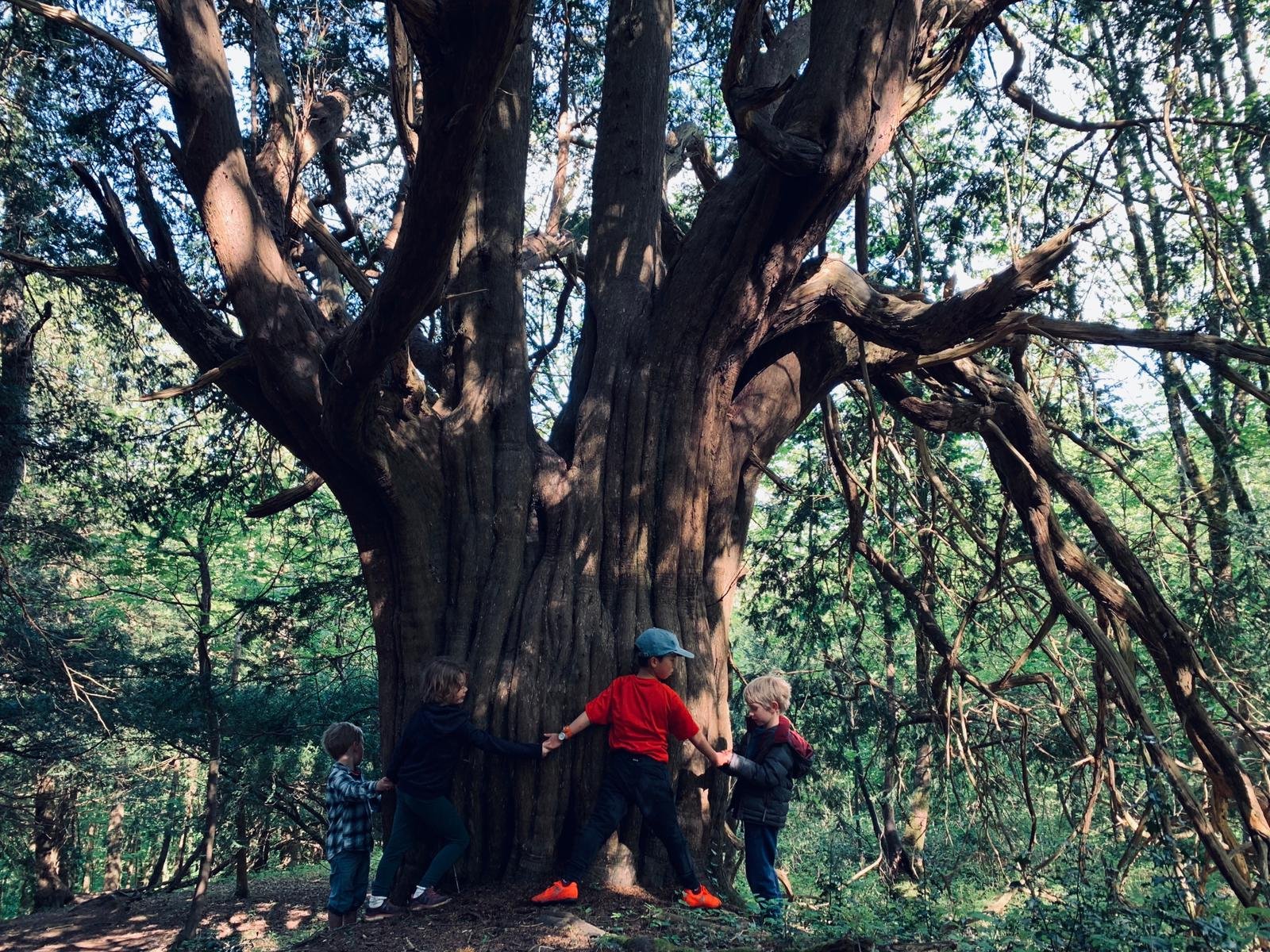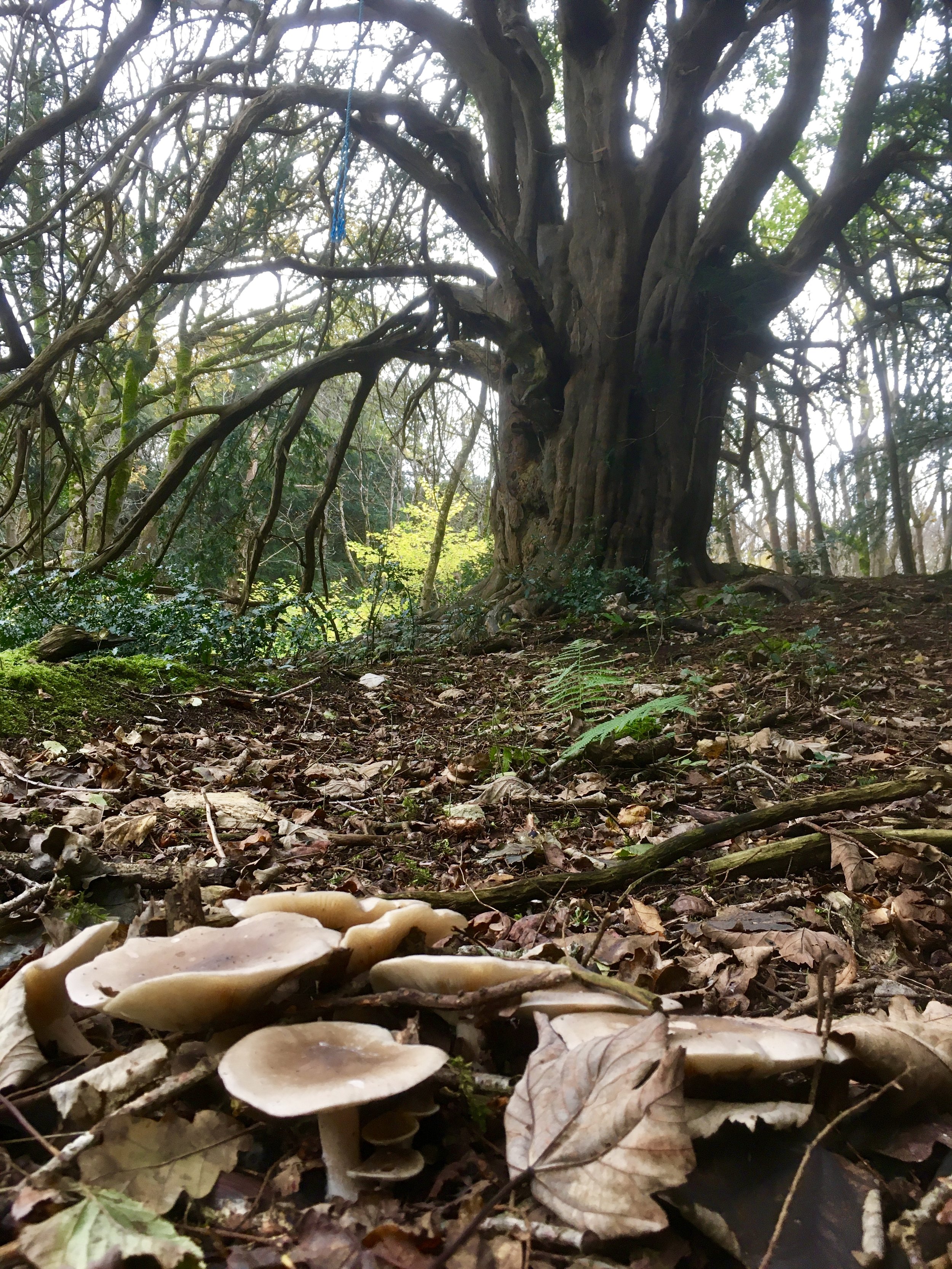‘Yew’ Bourton Combe, Flax Bourton
Yew (Taxus baccata)
The yew tree is native to Britain and was held sacred by the Druids in pre-christian times. Its longevity and regeneration invite symbolism of death and rebirth. Old trees can survive even when their trunk dies, and boughs touching the ground can sprout new trunks. No matter how old the tree is, it can produce new basal shoots. Multiple yews can come together and form one yew tree. Yews can survive tough conditions and produce hard timber which was used for furniture, musical instruments and notably for longbows in the Hundred Years War. The leaves and seeds are poisonous but the fleshy bright red arils surrounding the tiny cones are attractive to greenfinches and hawfinches.
Symbolism: Eternal life and rebirth; the duality of life and death; change and transformation, perseverance; protection; power and strength.
About the tree:
When my son was little we measured the girth of this tree and entered it into a tree age calculator. The circumference of yew grows at roughly 1.25cm a year so this tree is could nearly 900 years old. It started its life at a time when the majority of England’s population were peasant farmers subject to noble overlords. I remember we talked about what life would have been like, what the countryside around the tree would have looked like, and we went home and made ‘pottage’ for lunch.
Yews are dioecious, meaning the male and female flowers grow on separate trees. I have never seen berries on this tree so I assume it is a male. However I have heard that sometimes part of an old tree’s crown can switch sex, which is intriguing. I have often sat with this tree and feel that for me it has a feminine energy. A dark earthy energy. I come to this tree when I need to connect to my inner strength. When I am feeling overwhelmed by the demands of life I find peace here, and a feeling of settling and stilling. Here I can connect to a feeling of strength that isn’t about pushing and striving and battling. It is a deeper rooted feeling of regeneration and wholeness. From this comes a perspective on my struggles. For me this tree is all about solace.
About the woodland:
Bourton Combe is a magical valley full of trees heavily ladened with moss and lichens. There are many gnarly old yew trees as well as oak. In spring there are magnificent carpets of wild garlic, and in autumn the wood abounds with fungi. Some spectacularly large fairy rings develop just below this tree. Much of North Somerset is characterised by a network of carboniferous limestone ridges and combes separated by floodplain. The hidden, deep wooded combes and gorges extend into the scarp slopes providing important historic routeways and steep, winding rural lanes. Bourton Combe is part of the Cleve Ridge, which also includes Brockley Combe and Goblin Combe further to the west, but this little combe is much less known.
Continuing to follow the path up the hill, with rhododendron on your right and stands of young silver birch and sycamore on your right, you will come to a small grassy plateau overlooking the valley. A walker once told me that when he was a boy the grassland here was much larger and grazed by sheep. Look out for lovely limestone plants such as ladies bedstraw, salad burnet, quaking grass and common rock-rose. Looking out over the valley if you take the path on your left you will find a magical glade of twisty yew trees. A perfect cool shady spot for meditation, movement practise or tree climbing. Then if you go back across the open grassy glade to the opposite side and take the path running alongside the valley south east you will find a couple of rope swings for the kids. Continue on and eventually you will find a wide track leading off to the right which takes you down into the valley. You can then walk back to your starting point along the bottom of the Combe. This can be muddy, but is wonderful on rainy days, when the moss and ferns become so vibrant and the boughs of the yew trees dark and glistening. The Combe runs adjacent to a large quarry. The noise from this is not normally too intrusive but for real peace and quiet visit the wood at the weekend.
Directions:
GPS: ST 50563 68751
What3words: barman.bells.upwardly
Bike:
From the Bristol Harbourside By the MShed museum you can take the Festival Way, which is part of National Cycle Route 33 http://www.gps-routes.co.uk/routes/home.nsf/RoutesLinksCycle/festival-way-cycle-route# You take Cumberland Road alongside “The Cut” (the man-made route of the River Avon) and then out of town and along the bottom of Ashton Court Park. Continue through the villages of Long Ashton and Cambridge Batch and exit the cycle route where it crosses Station Road. Turn left into Station Road and enter Flax Bourton village. Continue until you meet Main Road (A370). Turn right here, and go past the church on your right and then at the end of the village turn left into Stancombe Lane. Be aware this lane has lorry traffic from the quarry during the week. Where the lane turns to the right you will see ahead of you a metal gate into a field marked as a public footpath. You can follow the walking instructions from here. Mountain bikers do use the woodland tracks but these are unofficial routes as far as I am aware and some are very steep. I feel it is more sensitive to the woodland to walk from here and really take the time to take in this beautiful limestone Combe.
Train and bike:
Trains go regularly from Bristol Temple Meads to Nailsea and Backwell station. Take Station Road through Backwell until you reach Farleigh Road (A370). Turn left here and cycle through the village of Farleigh and then take Stancombe Lane on your right. The A370 is a fast road and not suitable for cycling with children. There are alternative lanes you can cycle along but this will be much more circuitous. You can use the map links above to work out a route.
Bus:
From the C7 bus stop at St. Augustine’s Parade in Bristol city centre you can catch the X1 bus to Flax Bourton. Get off at the Post Office Lane bus stop on Main Road just after you have passed the St Michael All Angels Church on the right. Walk a few minutes further along Main Road to the end of the village and turn left into Stancombe Lane and follow the walking directions from the lay-by.
Car:
Take the A370 west out of Bristol. At the far end of the village of Flax Bourton turn left into Stancombe Lane and park in the lay-by on the left.
How to find this tree:
Go through the wooden gate (marked with a big quarry stone) at the side of the lay-by in Stancombe Lane. Follow the gravel path alongside the road, going straight ahead through a second wooden gate. At the end of the gravel path go through the metal gat into the field, marked with as a public footpath. Go straight ahed and through the next metal gate. The path with then take you through a second field and into Bourton Coombe woodland. Follow the main path straight ahead, crossing a fallen tree. The path splits briefly into two. If you take the right hand route it goes between two earth ramps made by mountain bikers. From here continue straight ahead for 25 paces, at which point you will see a path to your left at 45 degrees that heads steeply up the bank. Follow this path up the hill and after a few minutes you will see the yew tree on your right.

